YuYu interview Dr. Kouzi Suzuki
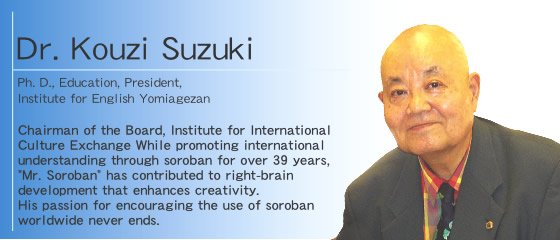 |
| —— Can you tell us about the Institute for English Yomiagezan (dictation of a list of numbers) for which you serve as President? I have been engaged in mathematics education and have taught soroban (Japanese abacus) for over thirty years in schools, from elementary to college, in about twenty countries, including the US, the UK, Canada, Mexico, Brazil, Australia, Vietnam, India, China, Taiwan, and South Korea. Using my experience, I founded the Institute for English Yomiagezan in Tokyo in 1984. English yomiagezan is a learning approach in which students listen to numbers read aloud in English and calculate those numbers with a soroban. This helps them become skilled in English and calculation at the same time. An advanced learner can calculate numbers instantly without physically using a soroban. This is because he or she can visualize the soroban frame. English yomiagezan helps not only to develop the left brain through listening to English pronunciation, but also the right brain, which controls creativity through anzan (mental calculation) performed through the visualization of the soroban frame. English yomiagezan seems easy, but it is actually quite difficult. English pronunciation of numbers includes D, F, L, R, TH, and V, which are difficult for Japanese speakers. Calculation through English yomiagezan requires students to understand English numbers as read, instead of mentally translating them into Japanese. Also, it helps students develop their ability to concentrate, because they must always prepare themselves for calculation with a positive intensity, trying not to miss numbers read aloud in English. 
Dr. Suzuki was the yomiagezan Japanese champion twice in a row during his college years.
I started when I was finishing the sixth grade, so I got a late start studying the soroban. I started going to a soroban school with a friend. I hadnユt ever touched a soroban before, so I brought a thick wooden framed soroban that I had found at home, which made everyone in the class laugh. I started studying out of curiosity, but soon got hooked on it, so much so that I went to that school every day. After a year and half, I had achieved the 1st-level of kyu on the soroban proficiency test. Yet, my teacher encouraged me to develop my skills even further. I followed his advice and took another test for the 1st level. I again passed the test, this time with a perfect score. In those days, the 1st level of kyu was the highest level that a person could achieve. So, the next challenge for a 1st-level soroban learner was to take part in competitions. I once participated in a national competition, but found it far beyond my skills. That made me realize that there were many in Japan who had passed the 1st level with a perfect score and there was still a lot of room for improvement of my skills. I was upset with my failure, so I started practicing soroban even harder than before. —— What made you decide to teach soroban in English? I continued practicing soroban throughout college. When I was a sophomore in college, I became the Japanese champion in a yomiagezan competition. To my delight, I was able to win the Japanese championship again the next year. I then began to think that it would be wonderful to popularize soroban overseas. So I did some research on my own, checking mathematics textbooks published in the US and the UK, as well as, English soroban books published in China. Yet, I didn't have a specific plan to teach soroban abroad. Keeping my ambition to myself, I went to graduate school and at the same time started teaching in a commercial high school. An opportunity came to me in 1964, when Olympic games were held in Tokyo. A student of a teacher that I knew was serving as mayor of the Olympic Village. I asked him to let me meet track and field athletes from the US. I showed them soroban as an activity of international cultural exchange. I taught soroban, using English phrases that I had memorized. Later on, the League for Soroban Education of Japan, which had heard of me, asked if I would be interested in teaching soroban in America. So the next year, I went to Los Angeles on assignment. I was twenty-eight years old then. 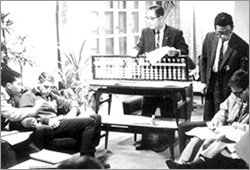
Dr. Suzuki teaching soroban to American athletes in the Olympic Village in Yoyogi.
I didn't expect this before leaving Japan, but I found that I was just a visitor in the US. There was no organization to which I would belong, nor students who would want to learn soroban. Even Japanese Americans would say, "I wonder if there are people who would still want to learn soroban now." Still, I had a strong desire to introduce the soroban, a handy instrument. So, I visited schools every day on a voluntary basis to demonstrate soroban. I was on an assignment from the League for Soroban Education of Japan, but all I was provided with was a one-way flight ticket, no living allowance was provided. I was studying English at an adult school during the day and made my living by working part-time for a printing company, from midnight to six the next morning. Things were difficult financially. However, after a few years, I started receiving letters of appreciation and requests for appearances from the schools that I'd visited. One day, while I was visiting a lawyer to prepare my application for a visa extension he said, "Mr. Suzuki, you have an eye for something unique, soroban!" According to him, my skills and experience, along with the letters of appreciation and requests from the schools, would serve as evidence that I had special skills to be qualified for permanent residency. Later on, the government acknowledged that soroban was useful in mathematics education, which granted me permanent residency four years after coming to the US. 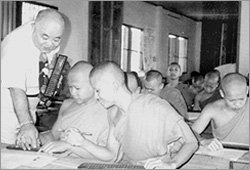
Dr. Suzuki teaching soroban to young monks who would lead Laos in the future.
I got a job offer from a company, but I asked myself, "What was my purpose in coming to the US?" I kept asking myself that, all the while working hard to promote soroban. One day, I taught a workshop at a conference in Sacramento held by the California Mathematics Council (CMC). After the workshop, a participant told me that he wanted a big soroban and thirty regular-size sorobans. That person was Dr. Richards of the University of Southern California. Dr. Richards, who taught teacher preparation programs at USC, said to me, "Soroban is an ideal educational instrument for understanding the basic concepts of mathematics. I'd like to introduce soroban to my students who are going to be teachers." I sent him the sorobans he had requested right away. That surprised Dr. Richards, who said, "Nobody has ever sent me an order before I've paid!" Since then, we have developed a trusting relationship with each other. With his understanding of soroban and support, we founded the Soroban Institute at USC, which helped us start promoting soroban education on a much grander scale. 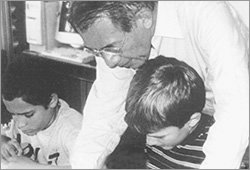
A workshop at Torrey Pines Elementary School in La Jolla. Mr. Kuniaki Miura, a member of the Institute for English Yomiagezan, is opening a soroban school in San Diego in July 2004.
In learning mathematics, it is more difficult to understand how numbers work in English than in Japanese. For example, in English, we say 11 "eleven," instead of "ten one." Some of the other languages, including French, Spanish, and Portuguese, have the same concept of numbers. Children who speak these languages don't have a concept of the ones, tens, and hundreds places. As a result, they tend to have difficulty in understanding the basics of mathematics, including base ten and place value, and they tend to dislike mathematics. Meanwhile, on the soroban frame, numbers from 0 to 9 are displayed in one column and 10 in the next column, which helps students understand base ten and place value. When I visited an American elementary school in Japan, a teacher thanked me very much for teaching her students. She said with joy, "When I taught base ten or place value, the students understood only 50% of it. But today, you taught them using the soroban for only ten minutes and they understood completely!" In this way, soroban has gotten attention in many places, including Europe, South America, Asia, which has allowed me to travel to five of the continents, except Africa and Antarctica to teach soroban. Children call me "Mr. Soroban" or "the Soroban Man." (Laughter) 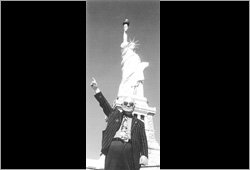
The "Soroban God" smiling in front of the Statue of Liberty.
When I was studying English at the adult school, there was a Japanese lady in the class who seemed to be in her seventies. I talked to her, and she told me that she was from Japan and had lived in the US for fifty years. She had come to the US as a picture bride, and when her family had become able to make their living, the war broke out and they were interned into a concentration camp. So, she didn't have a chance to learn English. She didn't have to make an effort to speak English for the rest of her life because her children, who understood Japanese, would translate for her when she needed. I asked her why she was studying English now. She said with a big smile, "I love my grandchildren. I can communicate with second-generation Japanese Americans in Japanese, but to communicate with the third generation I need to speak English." I think, I was inspired by her to make an effort every day. —— Who had a big influence on you? I greatly admire Mr. Keigo Yamada, my mentor at the soroban school. He taught me how to cultivate perseverance and self-control and how fascinating arithmetic was. One day, Mr. Yamada said to me, "You shouldnユt be overly proud of yourself just because you have some soroban skills. There are still things that you don't know" and he let me know that there used to be a "9-by-9 Division Table" in addition to the "9-by-9 Multiplication Table." The "9-by-9 Division Table" is an approach to remembering division involving one-digit numbers when the dividend is smaller than the divisor. It includes a collection of Japanese puns. For example, "two, one, five in heaven" means that 1 divided by 2 is 0.5. "Three, one, three ten, and one" means that 1 divided by 3 is 0.3, remainder 0.1. This helps you memorize division that produces numbers less than 1 (up to one digit after the decimal point) and their remainders. Although I had heard of the "9-by-9 Division Table" for the first time, Mr. Yamada ordered me to memorize it overnight. The next day, he had me recite it to him. When I stumbled over a phrase, my teacher gave me a smack on the head. (Laughter) 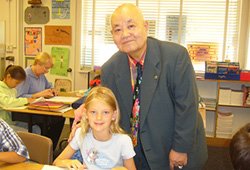
At a workshop held at Torrey Pines Elementary School in La Jolla, Dr. Suzuki poses for a picture with Austrian-born Ms. Xenia, who is also fluent in German, May 27,
The answer to a calculation with soroban is right or wrong only. There's no room for ambiguity in it. I myself don't like the unbending mentality, but when it comes to fairness, soroban doesn't allow subjectivity to influence calculation results. I think that's why soroban appeals to many people. I'd like people all over the world to know the educational benefits of soroban. With this wish, I'll continue to devote my life to mathematics education, traveling around the world. A current and future task is to focus on training my successors. I don't want them to have the same financial difficulties as I did when I was young, though. So, I hope we'll establish a system for getting sufficient funds to promote soroban. It may be an "occupational hazard"numbers are always circling around in my head. For example, when I see a license plate of a car in front of me, I automatically multiply or add numbers on the plate. That's not useful in daily life at all, but I guess it's a conditioned response that I've developed. (Laughter) I believe, though, it's an important part of training in soroban, so I'll continue to pursue my "soroban life." Kouzi Suzuki ・・・・・・・・・・・・・・・・・・・・・・・・・・・・・・・・・ Dr. Kouzi Suzuki, Ph.D., Education, is president of the Institute for English Yomiagezan (dictation of a list of numbers) and Chairman of the Board of the nonprofit organization, the Institute for International Culture Exchange. He also served as Director of the American branch of the League for Soroban Education of Japan, Inc. He was born in Utsunomiya, Tochigi Prefecture in 1937. He graduated from Chuo University, Faculty of Commerce in 1959 and entered graduate school at Nihon University, College of Economics in the same year. He received his Ph.D. in education from an American university in 2000. While attending Chuo University, he became the yomiagezan champion winning the national soroban championships two years in a row. After working as an instructor at a soroban school and a teacher at a commercial high school, he came to the US in 1965 on assignment from the League for Soroban Education of Japan, Inc. For over thirty years, Dr. Suzuki has instructed teachers on soroban, at more than 300 public schools and colleges in the US, including UCLA, as well as, schools and universities worldwide and continues to do so. He has published seven books in total, both in English and Japanese, and appeared as a lecturer in "English Conversation III" on NHK TV. He currently lives in Tokyo with his wife. (07-01-2004 issue) |

